How To Quickly And Successfully Germinate Cannabis Seeds
- How to germinate cannabis seed
- In a paper towel
- In soil
- In a glass of water
- Cotton wool
- Germinating auto seeds
- Alternative methods
- In peat pellets or starter cubes
- In rockwool cubes
- A comparison table
- Germinating for hydroponics
- How long cannabis seeds germinate?
- How to germinate old seeds?
- Tips for caring after germination
- Is it legal to germinate cannabis seeds?
- FAQ

All cannabis plants, whether tall and lanky Sativa trees or compact and sturdy Indica bushes, start from a single weed seed. This tiny brown nut contains everything necessary to eventually yield hundreds or even thousands of grams of potent buds! However, to reach that point, it’s important to place the seed in a special environment that will trigger life inside it, crack the shell open, and let the roots and stalk out.
In this article, we’ll be explaining how to germinate cannabis seeds and tell you about the best ways to do it. Before we start though, it’s important to know what environment cannabis seeds are most likely to pop in. Since in nature, they germinate in spring, logically, you want to put them in conditions that mimic fertile ground in spring – think plenty of moisture, little light, and mildly warm temperatures of around 18-22 C (64-71 F). Now, you’re ready to learn about the best ways to germinate cannabis seeds. Let’s dive right in!
Main Methods Of Cannabis Seed Germination
The following three methods have proved to be some of the easiest as well as the most effective. This means each of them is a great way to help your cannabis seed to sprout.
How To Germinate Marijuana Seeds In A Paper Towel
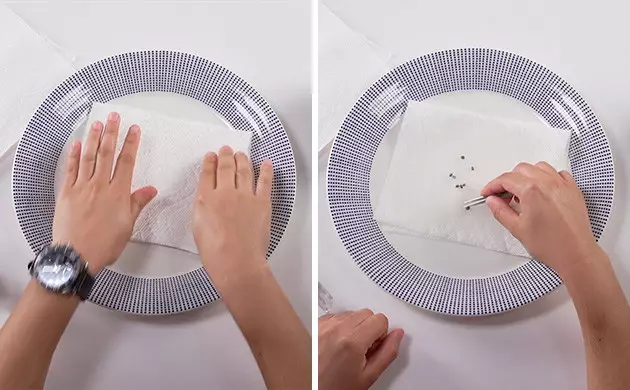
This method is a true classic that’s been shared grower to grower for generations. It’s also pretty simple and has everything you need to maintain the perfect environment for cannabis seeds to pop.
The paper-towel method should be the default one for beginner growers. It’s so simple and straightforward that it leaves very little room for mistakes and things that can go wrong. When seed breeders vouch for the viability of their seeds, they have the paper-towel germination method in mind. It’s really that reliable.
The idea is very basic: moisten a paper towel and keep your seed between its layers until it cracks open. Now, let’s look at the whole process step by step.
1. Take a piece of a kitchen paper towel and fold it. If it’s thick and sturdy, one layer will be enough. With thinner varieties, you might need two layers.
2. Now, moisten it with water. It should definitely be of drinking quality. By all means, avoid using tap water, even if you let it sit to dechlorinate for 24 hours.
3. You want to give your seed only the best right from the start, so invest in a bottle of good potable water – non-carbonated, non-mineralized – and preferably a glass bottle, not a plastic one. Distilled water would be an even better option, and the same goes for rainwater (if it’s collected in a clean vessel).
Now, how much water should you use? If you have a plant mister, place the folded paper towel on a saucer first, then put the seed between the folds, and make 2-3 ample sprays until the paper is fully saturated with water. However, it shouldn’t run off when you tilt the saucer – that would be too much moisture.
Without a plant mister, it’s more or less the same; just use a teaspoon instead. Saturate the folded paper towel with a seed inside, but not to the point where it runs off when you tilt the saucer. If you’ve added too much moisture, gently squeeze out the excess.
4. If you’re germinating multiple seeds at once, make sure to space them so that their taproots have enough room to grow.
5. Now, cover the saucer with a second saucer and place them in a dark, warm place, such as your kitchen cabinet. Don’t let the towel dry out, and aim for a temperature range between 22-27°C (72-80°F).
One of the pros of the paper towel method is that it lets you regularly check if the seed has germinated. Don’t be overzealous – only first look inside the paper towel after 12-24 hours, and then check every 12 hours. Depending on the seed's vigor, the thickness of its outer shell, and other factors, you should typically see it crack open within 36-48 hours, although it may take longer in rare cases.
There are a few improvements you can use. For example, as an alternative to using a paper towel, you can place each seed between a pair of cotton pads – these will be easier to open when it comes to removing the seed. Instead of using saucers, you can also place your seeds in an airtight container or a ziplock bag to ensure that the moisture is retained within the towel/cotton pads.
Additionally, you can pre-soak the seed by allowing it to float on the surface of water for several hours – this will make the hull soft and more permeable to moisture, increasing the chances and speed of germination.
Of course, you can use other ways to germinate seeds. Just keep in mind that the methods we describe below, such as soaking the seeds in water or planting them directly in the soil, come with a little extra risk. So, if germination doesn't work out using these techniques, they’re not covered by our guarantee.
Germinating Cannabis Seeds In Soil
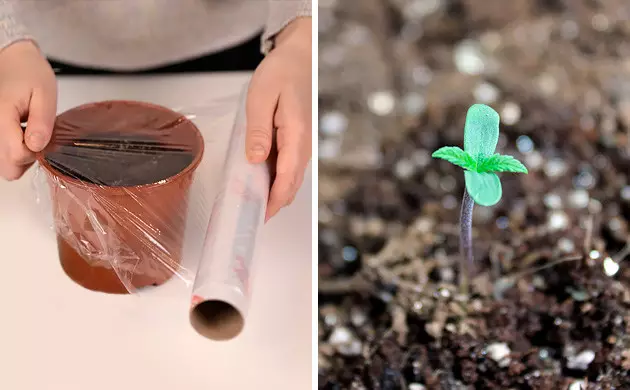
When spread naturally, marijuana seeds germinate directly in soil. So, why not recreate the natural process? This method is great for beginners because of how few steps it requires. All you need to do is make a 1.5-2cm (0.5-1 inch)-deep hole in the soil, place your seed in it, and lightly cover it with more soil. Then, water the spot above the seed and keep an eye on it to make sure the area stays moist most of the time. It’s also a good idea to cover your starting pot loosely with a plastic bag or a wrap to keep the environment humid and warm until the seedling shows up from the soil. This method is preferred by many because it eliminates the stress of transplantation that, at times, can be too tough on fragile seedlings.
Germinating Weed Seeds In Water
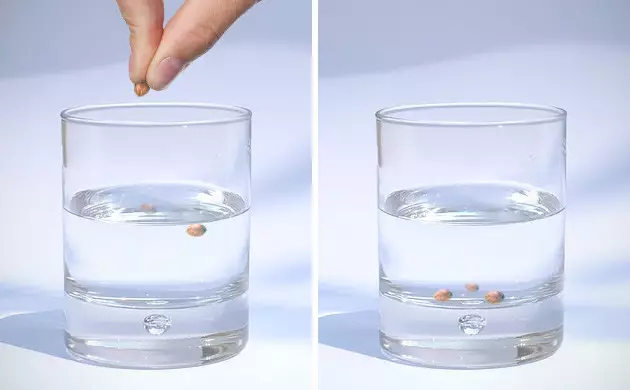
If you’re not ready to get your hands dirty just yet, it’s fine! Some growers start their seeds in a glass of water. This method is easy and quite effective. Practice shows that germinating in water normally makes around 90% of weed seeds pop. This method is pretty self-explanatory – all you need to do is place your cannabis seeds in a glass of fresh water away from light. Usually, the nuts crack open on the second day. For older seeds, however, the process may take up to 7 days, which is also fine. After the taproot shows, the seed is ready to be planted. Some growers wait for the seeds to drown (about 24 hours in), then transfer them to a wet paper towel.
How To Germinate Cannabis Seeds In Cotton Wool
Start with making a layer of cotton wool moist but not dripping wet, so that the excess water won’t suffocate the seeds. Then place your seeds on top, cover them with another layer (also moist), and put everything in a dark place.
Make sure the cotton wool is covered and won’t dry out while the seeds germinate.
The difficulty with germinating cannabis seeds in cotton wool is that the emerging roots may get entangled in it. For this reason, it’s better to use cotton pads in which cotton is more compacted and there is less fiber sticking out.
How To Germinate Autoflower Seeds
Cannabis is cannabis, and germinating autoflower seeds is exactly the same as any other variety. Just make sure to use the most effective technique because with autos you don’t want to lose any time at any stage, including germination.
Also, autoflower growers often choose the straight-into-the-final-pot method of germination to spare their precious babies any shock of transplanting.
Alternative Methods Of Cannabis Seeds' Germination
Now let’s move to the more modern methods of cannabis seeds germination. These aren’t necessarily better in terms of germination rate, but still have some pros as well as cons that we find important to explain.
Germinating Cannabis Seeds In Peat Pellets Or Starter Cubes
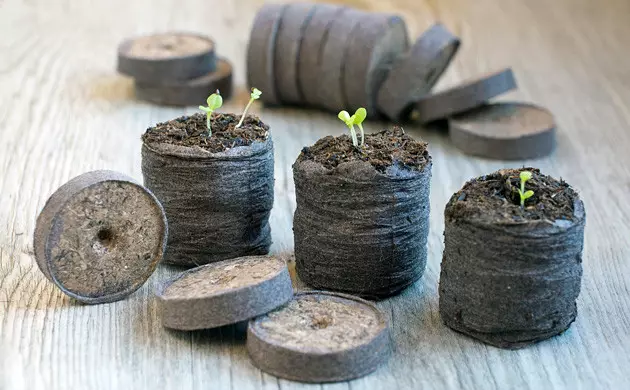
If you want to give your seeds special treatment and make them feel loved from the very first day in your grow op, you might want to get your hands on peat pellets or starter cubes. So, how do you germinate marijuana seeds in rapid rooters, peat pellets, and starter cubes? These are all individual plugs of peat or a special seed starter mix that are incredibly easy to use and don’t leave much room for error. In the case of peat pellets (you may also know them as jiffy pellets), all you need to do is soak them in warm water, which will make the pellets expand. Then, squeeze the excess moisture out and place your seed (pointy side down) inside the pellet. Starter cubes and rapid rooters don’t require squeezing, but whatever you choose, you need to make sure your medium is slightly moist at all times. One of the greatest advantages of this method is that the seed germinates in complete peace and doesn’t need to be transferred from the pellet/starter cube/rapid rooter. After the seedling is out, just plant it into the soil together with what you were germinating the seed in.
If you’re wondering how to germinate marijuana seeds for hydroponics, peat pellets, unlike other methods from this article, aren’t suitable for hydroponic setups. However, the rest of the techniques we’ll be discussing can be used for both soil and soilless media.
Germinating Cannabis Seeds In Rockwool Cubes
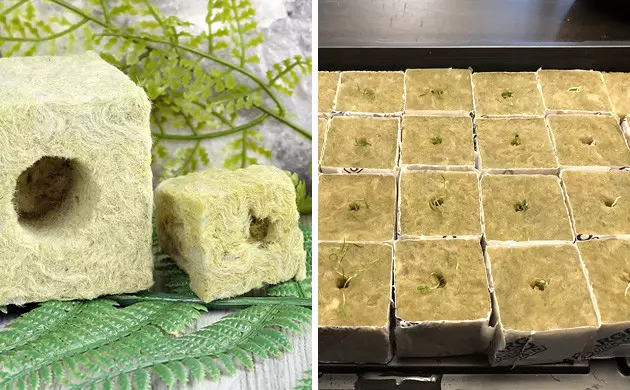
If you’re growing your seeds in a hydroponic setup, you might want to look into rockwool cubes for germination. As a material, rockwool is inert, cheap, and easy to find. Fans of hydroponic grows often choose rockwool for its mold-resistant qualities. The process of germination in rockwool cubes is the same as described in the previous method: simply place a seed inside a cube, water it, and keep it moist until the seedling is out.
Even though many growers prefer using rockwool for germination of their cannabis seeds, this method has quite a few drawbacks. First of all, the pH of new rockwool is not suited for cannabis seeds. It’s far too high and needs to be lowered before use. That’s why rockwool requires soaking overnight in pH-ed water and properly rinsed afterward. The second drawback of using rockwool for germination is that it’s a synthetic material that’s bad for both your health and the environment. When working with rockwool, it’s advised to use gloves and protective masks, because little pieces of the material can easily get into your mouth, eyes, and even end up in your lungs. Lastly, germination rates for seeds placed in rockwool cubes aren’t that great either – you can wait for your seeds to pop for weeks without any result.
Cannabis seed germination methods comparison table
In this article, we’ve covered five main germination methods. To sum everything up, here’s a comparison chart that can help you decide on how to germinate your marijuana seeds.
How To Germinate Cannabis Seeds For Hydroponics
DWC systems have seen a huge rise in popularity among home growers, making the question of germinating cannabis seeds for hydroponics extremely relevant. Is it any different? Not really, because the basics stay the same. You can still start with the paper towel method or a glass of water. However, we suggest using either starter cubes or rockwool when germinating cannabis seeds for hydroponics, as this will take the risk of damaging the sprouts to the minimum.
Here’s what you’ll need to do:
- Soak your starter cubes or rockwool pieces in clean, pH-neutral water for an hour.
- Place a seed inside the cube.
- Put the starter cubes/rockwool cubes with seeds in them inside the grow tray.
- Fill the bottom of the grow tray with an inch (2.5cm) of clean water or a very light nutrient solution.
- Dial in the temperature (20-30C/69-89F) and humidity levels (80-90%).
- Keep the lid on for conditions close to a greenhouse.
That’s it! After a couple of days, you’ll see your sprouts emerging.
How Long Does It Take For Marijuana Seeds To Germinate?
Your preferred method won’t make much difference in how long it takes for marijuana seeds to germinate. What actually matters when it comes to germinating cannabis seeds quickly is the quality of the seeds, their genetics, and how old they are. Normally, fresh seeds of good quality will never take more than 5 days to show taproot. However, if your seeds have been waiting for their hour for a little too long, it may take them around 10 days to germinate. Luckily, this won’t affect any characteristics of the future plant.
How To Germinate Old Cannabis Seeds
There are several tricks for germinating old cannabis seeds, all of them aimed at making the shell softer or thinner to help the sprout break out:
- Germinating cannabis seeds with hydrogen peroxide. Before germinating old cannabis seeds, try soaking them in a glass of room-temperature water with a teaspoon of hydrogen peroxide mixed in. This solution will help rehydrate and soften the seed’s shell. After 24 hours in this solution, switch to your preferred germination method.
- Scarifying old seeds. This is another proven method of germinating old cannabis seeds. Try lining a small matchbox with sandpaper, placing the seeds in, and shaking them there for about a minute. This will cover the seeds in microfractures, making it much easier for the sprout to break through. After scarifying the seeds, use your preferred germination method.
Tips For Caring After Germinating Seeds And Seedlings
As we’ve already pointed out, cannabis seedlings are very gentle, and you need to be careful not to put them in any danger or stress. Use the following tips, and your seedlings will make it safely to the next stage of their lifecycle.
Start Indoors

In order to germinate and survive the first days of life, cannabis seeds and seedlings need to be kept under certain conditions like warm temperature, high levels of humidity, darkness for seeds/lots of light for seedlings, and, of course, peace and quiet. Outdoor environments can therefore be too unpredictable – if the weather changes and brings heavy rain or wind, or if a bird or cat decides to try and snack on the seedling, the young plant most likely won’t survive and you’ll have to start all over. That’s why we recommend germinating your seeds and growing seedlings indoors, where you have full control over their environment.
Choose Soil For Seedlings Wisely
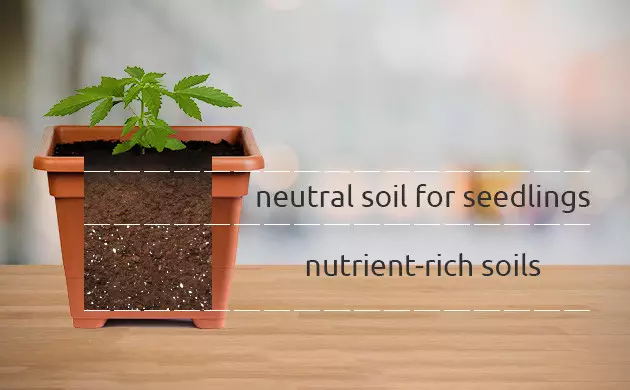
There’s a common term among growers used to describe soil extremely rich in nutrients, and that’s “hot”. While hot soil is beneficial for cannabis in general, especially when made and used correctly, hot nutrient-rich soils, or super soils, are not the best option for young marijuana seedlings. In the early stages of cannabis development, the plant’s nutrient needs are quite low, and too much of them can actually hurt the young plant’s health. So, make sure to use more neutral soil for seedlings. A good trick that you can implement in your practice is to cover nutrient-rich soils with a layer of a more neutral medium and plant the seedling in this upper layer. The plant will develop, and once it’s ready for bigger nutrient intake, its roots will reach the underlying “hotter” soil. Remember that the vegetative stage requires nitrogen-rich media.
Give Seedlings Enough Light
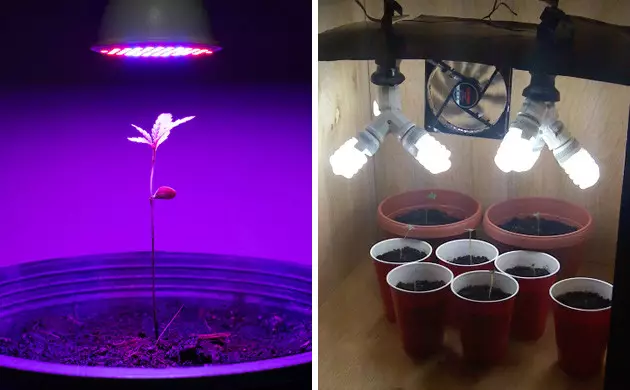
After spending so much time inside its dark shell, seedlings are hungry for light, and plenty of it! As we suggest starting your plants indoors, this means you’ll need to install a light to satisfy the seedlings’ needs. The vegetative stage of cannabis requires mostly blue light spectrum, so anything from fluorescent lamps to full-spectrum LEDs, 100W and up, will work fine for seedlings. Just make sure the light is placed close enough to the plants. The optimal distance for fluorescent lights is 5-6 inches (13-16cm) and 8-12 inches (20-30cm) for LEDs. In case the seedlings need more light, they will let you know by getting tall and leggy. This condition is dangerous for them, so make sure your baby plants are receiving enough light.
Keep Them In A Mini-Greenhouse
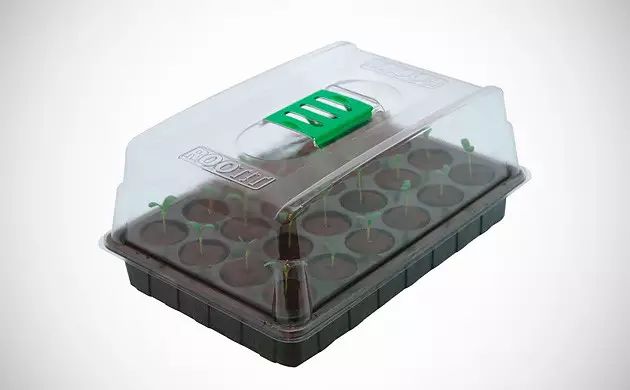
Finally, another nice touch to keep your sprouts safe and sound would be to provide them with a small improvised greenhouse of their own. Loosely covering the starting pots or pellets with a plastic bag will do the trick. However, in garden stores, you can also find specialized containers with tall transparent lids. Whatever you choose, this will help the seedlings stay warm, hydrated, and safe from any dangers of the outside world.
Is It Legal To Germinate Cannabis Seeds?
This is a tricky question to answer, as the situation depends on the jurisdiction of your country of residence.
If you’re a citizen of Canada, the U.S., the Netherlands, or Spain – all countries with lighter cannabis policies – it’s legal to germinate cannabis seeds. However, additional rules apply depending on what part of the country you live in and what seed type you want to germinate. Nonetheless, it’s safe to assume that germination of cannabis seeds is legal everywhere where it’s legal to grow cannabis, and especially if you’re planning to start a garden of medicinal marijuana, you likely won’t break any rules by germinating seeds of strains with THC content lower than 1%.
In other countries, governments may draw the line at germination. For example, in the UK, it’s legal to trade and keep cannabis seeds, but you have to be careful with their germination, as this is where the law gets broken.
In our blog, we’ve covered the legality of cannabis seeds and everything you can do to stay safe.
FAQ
What’s the best temperature for germinating cannabis seeds?
Cannabis seeds prefer a warm environment for germination, with the most optimal temperature being 25C (78F). However, it's okay to add/subtract a couple of degrees from this number while still keeping the air warm.
What's the best pH for germinating cannabis seeds?
The perfect pH for cannabis seed germination is between 5.5-6.0.
What's the best soil for germinating cannabis seeds?
It's better to use light, easily drainable soil for germinating seeds, as this will not restrain the growing sprout. The soil for germination and seedlings should also be neutral or very light on nutrients – “hot” and nutrient-rich soils are only suitable for mature cannabis plants.
What's the best humidity level for germinating cannabis seeds?
The germination stage requires high humidity levels of 80-90%.
What's the fastest way to germinate cannabis seeds?
All methods described in this article are more or less the same in terms of the speed of germination. Much more depends on the freshness of your seeds - the fresher the seeds, the sooner they will germinate.
Do weed seeds need light to germinate?
Weed seeds germinate in the dark. So, even after you put a germinated seed in soil, you can keep the lights off. Until the seed pops up through the surface, that is.
Will cracked seeds germinate?
The protective shell on seeds is there for a reason, so any cracks or chips decrease the chances of successful germination. However, much depends on how long ago the crack appeared. And, anyway, it never hurts to try.
How long for cannabis seeds to break soil?
If you put a dry seed into wet soil, don’t expect the sprout to appear sooner than 60 hours. For pre-soaked beans or those that were put into the soil when they had shown a taproot, this may happen earlier. Sometimes in as little as 12 hours.
Cannabis seeds sold in reputable seed shops sprout very fast. Seeds that are old or have been stored improperly may take up to 10 days to sprout.
Starting Off Right
Now you can see that growing marijuana from seed isn’t at all that hard. Just remember to give your seeds enough TLC and dial in some environmental conditions to fit their needs. We’ve shown you some of the easiest and most effective methods of germinating pot seeds. Which one is your personal favorite? Let us and fellow growers know in the comments below.
Herbies Head Shop expressly refuses to support the use, production, or supply of illegal substances. For more details read our Legal Disclaimer.

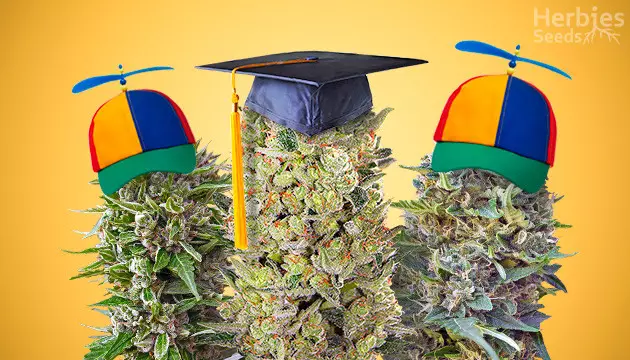







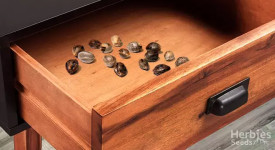



Thank you for leaving a comment for us!
Your feedback will be posted shortly after our moderator checks it.
Please note that we don’t publish reviews that: